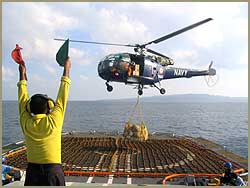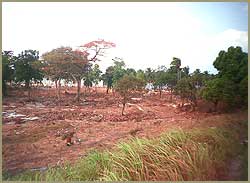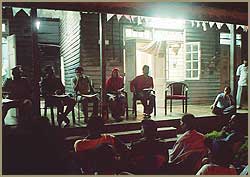|
St.
Johnís Disaster Relief Team in the Nicobars
Arrival
Overnight
at Chennai, the team stayed at the Andaman House
where we began receiving much needed but minimal information
and further contacts. On our arrival at Port Blair, we immediately
based ourselves at the Bishop's house and the adjacent Pilar
Health Center.A
group of us then proceeded to the Developmental Commissioner
(Health Secretary) Mr. Anshu Prakash and Director of Health
Services Dr. Ms Namita Ali presenting ourselves at their disposal
to be sent to places in most need for assistance. It is our
rule that we always report to the local civilian authority
to be directed to areas as needed locally and to ensure coordinated
efforts in the field.
 |
 |
| Airlift
medicines from our life line I.N.S. Rajput Capt Aiya |
They
were most kind to then orient us to the existing situation
and directed us to immediately leave on board the destroyer,
I.N.S. Rajput proceeding to the Nancowry Block of Islands,
south of Car Nicobar. The Commissioner on hearing of the nature
of our team agreed that additional nurses are the potential
need and immediately we got him on the phone to our Chief
of Medical Services, Dr. Mary Ollapally, who within an hour
had a team ready and they were flown into Port Blair the same
day. This second team was composed of five nurses and an orthopedic
doctor. The first team was assigned to Nancowry block and
this second team was sent into Car Nicobar initially and later
in the refugee camps of Port Blair. The
first team steamed at over 20-25 knots to their destination
and was flown by helicopter along with their medical relief
supplies to Kamorta, the headquarters of Nancowry block. The
second team was also flown into Car Nicobar. On board the
I.N.S Rajput, we were most fortunate to have a captain (Capt
Aiyappa) and crew most supportive of our efforts.
 |
 |
| Destroyed
village of Pilpillou on Kamorta Island |
The Principal Medical Officer, Surg Lt Cdr Rath, had been
posted on Kamorta Island, eight years ago and was a fantastic
source of local information on whose whom on the island. It
was his story about the "Queen and Prince" of Nancowry
that was most useful in being able to develop rapidly a rapport
to perform our duties on the island among the tribal population.
Rashid's (the Prince of Nancowry) presence during our meetings
made us even more acceptable to the community on the surrounding
islands. Rajput
airdropped us onto Kamorta where we reported to the Officer
on Special Duty Mr. Uday Kumar and the DySP Sarvanana, both
having arrived the previous day. They
were sent in since the Assistant Commissioner at Kamorta had
not returned to his island and his whereabouts were unclear.
That evening Uday Kumar and Sarvanana had a meeting of all
the Village Captains (elected leaders of the tribal villages
on all islands were called 'Captains') along with the contractors,
AE, Education Officers, PWD, Electricity, Telecommunication
staff, Port Control, the Princess (Ayesha), Prince (Rashid)
and everyone who was important for any sort of local coordinated
effort. On islands such as these, everyone who is someone
is so important that if even one is unhappy nothing gets done.
It
was sad to hear that as we left the islands Mr. Uday Kumar
was replaced by a seemingly competent Jt Secry Mr. P.R. Meena
from Delhi to oversee further affairs along with a fresh graduate
on his first posting as the new Asst Commissioner. DySP Sarvanana,
a Vice Principal of a Police training school at Port Blair
along with his young recruits played a most vital role of
disposing of carcasses on most islands, providing security
to relief supplies on islands and to medical teams in the
field. The
day we left, we missed him as had left at first light and
was involved in locating the last few 17 tribals marooned
in the jungle swamps of West Bay, Katchal Island. Of course,
as usual the local politicians (from both sides of the political
spectrum) slowed down any attempt to progress with work decisions
the group was trying so very hard to coordinate efforts. Need
we say that many were happy when some politicians actually
insisted on boarding some of the relief transport to neighbouring
islands and therefore being out of the way for a good many
days. The main limiting factors were the absence of appropriate
smaller vessels (Out board boats) to transport supplies and
personnel to the far-flung islands since most jetties were
destroyed and available motor vessels too large to beach;
inadequate communications between islands in spite of attempts
to place police wireless on all islands (unable to sustain
needs with low power in batteries in the absence of generators
that began to arrive towards the later part of our tenure).
 |
 |
| 8
pm meetings on Kamorta with local officials and the prince |
There
were three camps on the island of Kamorta where community
cooking and makeshift shelter was being provided. Rainwater
harvested provided drinking water for the refugees. These
islands had Tribals and Mainlanders. Most mainlanders were
government officials and their families apart from merchants.
There were many of them who had not been paid for bureaucratic
reasons of being from different islands hence different accounts.
On Katchal were the unique population of 1970s Sri Lankan
Tamilian refugees now settled on Rubber plantations unique
to inland Katchal. Apparently they had not been paid for over
three months and when the merchant shops opened on many islands
credit was unusual. On all islands we served the Tribals (Nicobari)
were non-demanding, simple people who had already begun reconstructing
their lives and shelters using locally available material
(thatched coconut leaves, bamboo and jungle trees). They knew
where the sources of drinking water streams existed and most
moved inland to settle on high points knowing they were relatively
safe from the fury of the coastal sea. It was difficult to
read the minds of these people but considering the stories
of survivors of the tsunami 10-18 meters high and at 400 kmph
chasing people inland through the villages and withdrawing
at similar speed, it must have been a terrifying sight. The
psychological impact must be tremendous on this docile, non-aggressive
population and will have to be addressed at the earliest to
enable any sort of true rehabilitation. The NIMHANS team that
usually follows us into the field every disaster would be
in the right position to assist in this aspect. What was unusual
is that the team was on the ground towards the second week,
which some would consider too early in the stage of relief
and rehabilitation.

Mr.
Ajit Chaudhuri, Executive Director & Ms.Skalzang Youdon, Programme
Officer
ajitc@intoday.com
Care
Today Fund, F14/15 Connaught Place, New Delhi 110 001, India
Telephone: 011 2331214 (direct) 011 23315801/2/3/4 Extn.287
|
|

